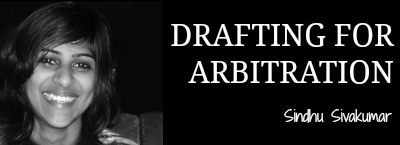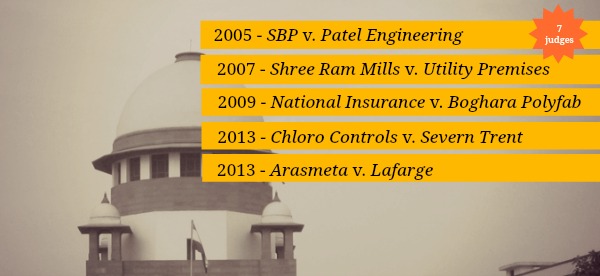
What questions can the Chief Justice entertain while appointing arbitrators under Section 11 of the Arbitration and Conciliation Act, 1996 (“the Act”)? In 2005, in SBP and Company v. Patel Engineering Ltd. (“the Patel Engineering case”), a seven-judge bench of the Supreme Court issued determinative dicta in relation to this function of the court. In this post, we examine a series of subsequent cases where the Supreme Court has interpreted and given effect to its dicta in the Patel Engineering case.
Background
Section 11 of the Act provides that when the parties fail to appoint one or more arbitrators according to the terms of the arbitration agreement, or when two arbitrators fail to choose the third or presiding arbitrator, or the designated appointment mechanism otherwise fails, the parties can approach the Chief Justice to resolve the stalemate and appoint an arbitrator.
Section 11 is based on Article 11 of the UNCITRAL Model Law, 1985 (“the Model Law”). Similar to the Model Law, Section 11 envisages the Chief Justice performing a fairly routine, administrative function in making the appointment, similar to the appointing role that arbitral institutions take on. All that is required is a request from a party to the Chief Justice to appoint the arbitrator, usually in the form set out in Notification No F22/1/95/SCA/Genl.The extent of enquiry in making the appointment should include checking for the impartiality and independence of the appointee and the qualifications specified in the agreement.
However, in the Patel Engineering case, the Supreme Court held that the appointing function in Section 11 is a judicial function where the Chief Justice should examine certain jurisdictional questions like the existence and validity of the arbitration agreement. The exact scope of enquiry of the Chief Justice was set out by the Supreme Court as follows:

“It is necessary to define what exactly the Chief Justice, approached with an application under Section 11 of the Act, is to decide at that stage. Obviously, he has to decide his own jurisdiction in the sense, whether the party making the motion has approached the right High Court. He has to decide whether there is an arbitration agreement, as defined in the Act and whether the person who has made the request before him, is a party to such an agreement. It is necessary to indicate that he can also decide the question whether the claim was a dead one; or a long barred claim that was sought to be resurrected and whether the parties have concluded the transaction by recording satisfaction of their mutual rights and obligations or by receiving the final payment without objection. It may not be possible at that stage, to decide whether a live claim made, is one which comes within the purview of the arbitration clause. It will be appropriate to leave that question to be decided by the arbitral tribunal on taking evidence, along with the merits of the claims involved in the arbitration. The Chief Justice has to decide whether the applicant has satisfied the conditions for appointing an arbitrator under Section 11(6) of the Act…”
Further, the Court in this case also held that the court’s decision on any of these preliminary matters would be final and not open for subsequent examination by the arbitral tribunal.
In subsequent cases, questions have arisen in relation to this dicta – in relation to whether the Chief Justice or his designate has to examine all the preliminary issues laid down in Patel Engineering or whether he can set aside some of these preliminary issues for the arbitral tribunal to decide. Questions have also been raised about the extent to which courts can examine the scope of the arbitration agreement while dealing with a Section 11 application.
Discretion to leave issues to the arbitral tribunal
In National Insurance Company Ltd. v. Boghara Polyfab Pvt. Ltd., (2009) 1 SCC 267, a two-judge bench of the Supreme Court held that the Chief Justice, in exercising his powers under Section 11, does not have to decide all the preliminary questions set out in Patel Engineering.
The Court segregated the preliminary issues into three categories, that is, “(i) issues which the Chief Justice or his designate is bound to decide; (ii) issues which he can also decide, that is, issues which he may choose to decide; and (iii) issues which should be left to the Arbitral Tribunal to decide.”
The first category included the Chief Justice’s territorial jurisdiction as well as the issue of whether there was an arbitration agreement and whether the Section 11 applicant is indeed a party to the agreement. The second, optional category included issues of whether claim is a dead (barred by limitation) claim or a live claim and whether the parties have concluded their contract by recording satisfaction of their mutual rights and obligation or by receiving the final payment without objection. If the Chief Justice did decide to rule on these optional issues, his decision would be final and cannot be reopened by the tribunal. However, the court urged the Chief Justice to exercise caution in exercising this option and to be guided by the objective of the Act of “expediting the arbitration process with minimum judicial intervention”. The last category of issues which the Chief Justice should not decide included issues of “(i) Whether a claim made falls within the arbitration clause (as for example, a matter which is reserved for final decision of a departmental authority and excepted or excluded from arbitration)” or “(ii) Merits or any claim involved in the arbitration.”
 The categorisation of the Court in this case is interesting, especially in relation to the second category, because in a previous case, Shree Ram Mills Ltd. v. Utility Premises (P) Ltd., (2007) 4 SCC 599, the Supreme Court had suggested that the second category of cases, involving the decision of whether the claim is a live claim or not, has to be decided by the court as it is only by deciding this limitation issue that the court can decide whether to constitute a tribunal or not. The Court said: “… the Chief Justice has to record satisfaction that there remains a live issue in between the parties…” and that “where the Chief Justice comes to a finding that there exists a live issue, then naturally this finding would include a finding that the respective claims of the parties have not become barred by limitation.”
The categorisation of the Court in this case is interesting, especially in relation to the second category, because in a previous case, Shree Ram Mills Ltd. v. Utility Premises (P) Ltd., (2007) 4 SCC 599, the Supreme Court had suggested that the second category of cases, involving the decision of whether the claim is a live claim or not, has to be decided by the court as it is only by deciding this limitation issue that the court can decide whether to constitute a tribunal or not. The Court said: “… the Chief Justice has to record satisfaction that there remains a live issue in between the parties…” and that “where the Chief Justice comes to a finding that there exists a live issue, then naturally this finding would include a finding that the respective claims of the parties have not become barred by limitation.”
In Chloro Controls India Private Ltd v. Severn Trent Water Purification Inc., (2013) 1 SCC 641, a three-judge bench of the Supreme Court said that there is no variance between the Shree Ram Mills Ltd. and Boghara Polyfab Private Limited judgments; both judgments were in line with the law declared in the Patel Engineering Case. Quoting from Shree Ram Mills, the Court clarified that it laid down that “it is only for the purpose of finding out whether the arbitral procedure has to be started that the Chief Justice has to record satisfaction that there remains a live issue in between the parties.
… The Chief Justice only has to record his satisfaction that prima facie the issue has not become dead by the lapse of time or that any party to the agreement has not slept over its rights beyond the time permitted by law to agitate those issues covered by the agreement….”
Thus, “…the Chief Justice may not decide certain issues finally and upon recording satisfaction that prima facie the issue has not become dead even leave it for the Arbitral Tribunal to decide.”
The Court also upheld the categorisation laid down in Boghara Polyfab Private Limited: “We have no reason to differ with the classification carved out in National Insurance Co. as it is very much in conformity with the judgment of the Constitution Bench in SBP.”
The scope of the arbitration agreement
In Arasmeta Captive Power Company Private Limited v. Lafarge India Private Limited, the Supreme Court in December, 2013, reiterated another aspect of the Patel Engineering decision, namely that the Chief Justice should not decide on whether the claim in question is one which comes within the purview of the arbitration clause or not. In 2005, the Supreme Court had said: “It will be appropriate to leave that question to be decided by the arbitral tribunal on taking evidence, along with the merits of the claims involved in the arbitration.”
In 2013, the question was whether the claims raised by the parties fell within the definition of a ‘billing dispute’ and thus, within the scope of the arbitration agreement. The Supreme Court categorically stated that the question fell to be determined by the arbitral tribunal and not the courts.
The Court said, “….the designated Judge… while dealing with an application under Section 11(6) of the Act, on an issue raised with regard to the excepted matters, was not justified in addressing the same on merits whether it is a dispute relating to excepted matters under the agreement in question or not…..The designated Judge has fallen into error by opining that the disputes raised are not “billing disputes”, for the same should have been left to be adjudicated by the learned Arbitrator…”
Thus, the third category of issues (under Boghara) are strictly for the tribunal to decide. With Arasmeta, the Supreme Court has shown that it is prepared to strictly enforce the jurisdictional line (between the court and the tribunal) and not further encroach upon the jurisdiction of the tribunal apart from what is necessary to appoint an arbitrator under Section 11.
(Sindhu Sivakumar is part of the faculty on myLaw.net.)
